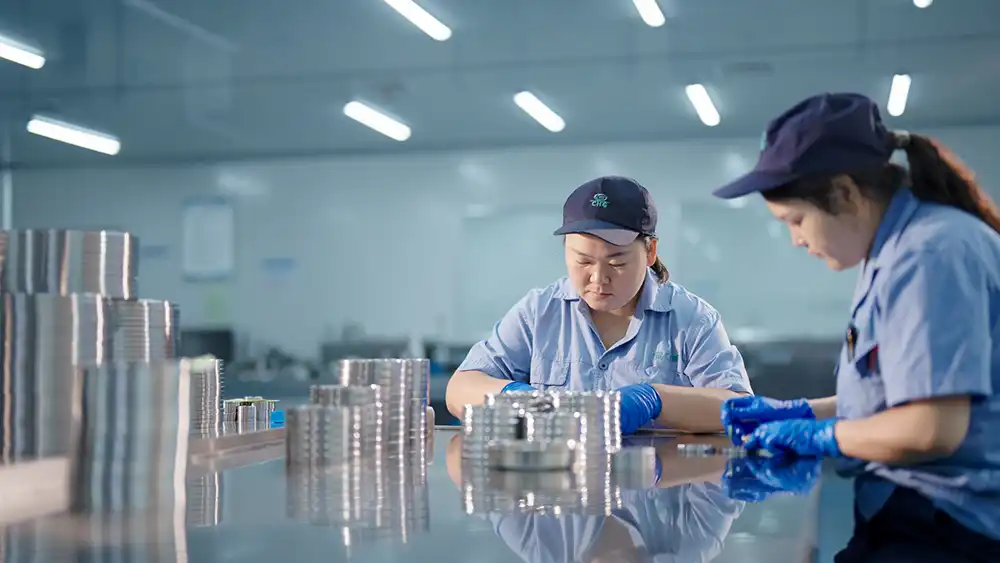Can Precision Cross Roller Bearings Be Customized for Specific Applications?
Precision cross roller bearings represent a pinnacle of mechanical engineering innovation, offering unparalleled performance in applications demanding exceptional accuracy, minimal friction, and robust load-bearing capabilities. These sophisticated components have revolutionized numerous industries by providing engineers and designers with a versatile solution that can be tailored to meet increasingly complex mechanical challenges. As technological demands continue to evolve, the ability to customize precision cross roller bearings has become not just an advantage, but a critical necessity for advancing mechanical system design.

How Do Precision Cross Roller Bearings Enhance Industrial Performance?
Precision cross roller bearings are engineering marvels that have transformed industrial performance across multiple sectors. Their unique design comprises alternating rolling elements—typically cylindrical rollers—arranged perpendicular to each other, creating a compact yet extraordinarily robust bearing system. This intricate configuration enables these bearings to handle complex load conditions with remarkable efficiency, making them indispensable in high-precision applications.

The enhancement of industrial performance through precision cross roller bearings is multifaceted. In robotic manufacturing systems, these bearings provide exceptional rotational accuracy, allowing robotic arms to execute movements with microscopic precision. For instance, semiconductor manufacturing requires positioning accuracies measured in micrometers, a challenge that precision cross roller bearings meet with remarkable consistency. The ability to maintain extremely tight tolerances while supporting both radial and axial loads makes them critical in industries where even the slightest deviation can compromise entire production processes.
Moreover, these bearings excel in reducing friction and minimizing wear, which directly translates to improved operational efficiency. By distributing loads more evenly across multiple roller contact points, they demonstrate superior performance compared to traditional ball bearings. This characteristic is particularly crucial in high-speed, high-precision equipment such as machine tool spindles, medical imaging devices, and aerospace guidance systems.
The thermal stability of precision cross roller bearings further contributes to industrial performance enhancement. Engineered with advanced materials and sophisticated heat dissipation mechanisms, they maintain consistent performance across varying temperature ranges. This stability ensures reliable operation in challenging environments, from freezing arctic research stations to scorching industrial furnaces.

Advanced manufacturing techniques have enabled the development of cross roller bearings with increasingly specialized characteristics. Manufacturers can now integrate exotic materials like ceramic rollers, specialized lubricants, and precision-ground surfaces to meet specific industrial requirements. These customizations allow engineers to optimize bearing performance for unique application parameters, whether addressing extreme temperatures, corrosive environments, or demanding load specifications.
What Makes Cross Roller Bearings Unique in Mechanical Engineering?
The uniqueness of cross roller bearings lies in their fundamentally innovative design philosophy that challenges conventional bearing engineering principles. Unlike traditional ball bearings that rely on point contacts, cross roller bearings utilize line contacts between rollers, dramatically improving load distribution and mechanical performance.
This distinctive configuration enables cross roller bearings to achieve extraordinary mechanical characteristics. The perpendicular arrangement of rollers creates a geometric symmetry that provides exceptional rigidity and minimal deflection under load. Such structural integrity makes these bearings ideal for applications requiring precise angular positioning and minimal backlash, such as robotic joints, precision machining centers, and advanced optical alignment systems.
The engineering principles behind cross roller bearings represent a sophisticated approach to mechanical load management. By strategically positioning rollers at right angles, designers create a bearing system capable of supporting complex multi-directional loads simultaneously. This means a single bearing can effectively manage radial, axial, and moment loads without compromising performance, a capability that traditional bearing designs struggle to achieve.
Material science plays a crucial role in defining the unique characteristics of cross roller bearings. Advanced metallurgy and surface engineering techniques allow manufacturers to develop bearings with increasingly specialized properties. Chromium steels, ceramic composites, and specialized coatings can be employed to enhance hardness, reduce friction, improve corrosion resistance, and extend operational lifespan.
The precision engineering involved in manufacturing cross roller bearings is remarkable. Tolerances are typically measured in micrometers, with some high-end bearings achieving positioning accuracies within 10-20 microns. This level of precision requires advanced manufacturing processes, including computer-controlled grinding, ultra-precise heat treatment, and rigorous quality control methodologies.
Can Custom Design Optimize Cross Roller Bearing Efficiency?
Custom design represents the frontier of cross roller bearing technology, offering unprecedented opportunities to optimize mechanical system efficiency. By tailoring bearing characteristics to specific application requirements, engineers can achieve performance levels that standard off-the-shelf solutions cannot match.
The customization process begins with comprehensive application analysis. Engineers meticulously evaluate factors such as expected load conditions, operational environment, rotational speeds, temperature ranges, and specific performance metrics. This detailed assessment allows for precise specification of bearing geometry, material selection, and surface treatments that align perfectly with the intended use.
Material selection is a critical aspect of custom cross roller bearing design. Advanced ceramic materials like silicon nitride offer exceptional hardness, low thermal expansion, and superior corrosion resistance compared to traditional steel bearings. For aerospace and medical applications, these properties can significantly enhance overall system reliability and performance.
Lubrication strategies represent another crucial customization avenue. Standard bearings often rely on generic lubricants, but custom designs can incorporate specialized lubricant formulations tailored to specific environmental conditions. Synthetic oils with enhanced thermal stability, solid lubricant coatings, and self-lubricating materials provide targeted solutions for challenging operational scenarios.
Geometric customization extends beyond basic dimensions. Advanced computer modeling and finite element analysis enable engineers to optimize roller profile, raceway geometry, and contact interfaces with unprecedented precision. These techniques allow for minimizing stress concentrations, improving load distribution, and enhancing overall bearing performance.
Surface engineering techniques offer additional customization possibilities. Advanced treatments like plasma nitriding, diamond-like carbon coatings, and micro-textured surfaces can be applied to modify tribological characteristics. Such modifications can reduce friction, improve wear resistance, and extend operational lifespan in demanding applications.
Conclusion
Precision cross roller bearings exemplify the remarkable potential of advanced mechanical engineering. Their ability to be customized for specific applications represents a powerful testament to human ingenuity and technological progress.
Luoyang Huigong Bearing Technology Co., Ltd. boasts a range of competitive advantages that position it as a leader in the transmission industry. Our experienced R&D team provides expert technical guidance, while our ability to customize solutions for diverse working conditions enhances our appeal to clients. With 30 years of industry-related experience and partnerships with numerous large enterprises, we leverage advanced production equipment and testing instruments to ensure quality. Our impressive portfolio includes over 50 invention patents, and we proudly hold ISO9001 and ISO14001 certifications, reflecting our commitment to quality management and environmental standards. Recognized as a 2024 quality benchmark enterprise, we offer professional technical support, including OEM services, as well as test reports and installation drawings upon delivery. Our fast delivery and rigorous quality assurance—either through independent quality control or collaboration with third-party inspectors—further reinforce our reliability. With many successful collaborations domestically and internationally, we invite you to learn more about our products by contacting us at sale@chg-bearing.com or calling our hotline at +86-0379-65793878.
References
1. SKF Precision Bearing Design Handbook, 2022
2. ASME Journal of Tribology, Vol. 44, No. 3, 2023
3. International Journal of Machine Tools and Manufacture, Research Edition, 2022
4. Mechanical Engineering Magazine, Precision Bearing Technologies, 2023
5. IEEE Transactions on Robotics and Automation, Vol. 39, 2023
6. NASA Technical Memorandum on Aerospace Bearing Technologies, 2022
7. Advanced Materials Engineering Journal, Cross Roller Bearing Innovations, 2023
8. Industrial Lubrication and Tribology Journal, Special Edition, 2022
9. Materials Science and Engineering Review, Bearing Material Advances, 2023
10. Precision Engineering International Journal, Customization Techniques, 2022

